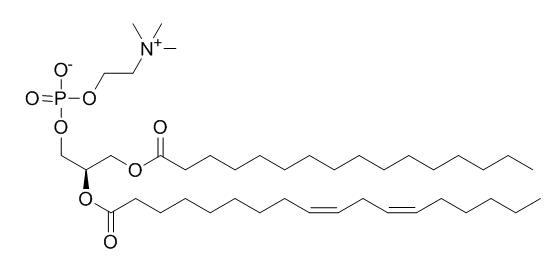Soybean phospholipid
Soybean phospholipid has a growth-promoting effect and it is suitable as a lipid and phospholipid source in microdiets for P. fulvidraco larvae feed.Soybean phospholipid and safflower phospholipid can suppress the elevation of plasma and liver cholesterol and that this effect may be brought about by inhibiting the absorption of cholesterol in the small intestine.
Inquire / Order:
manager@chemfaces.com
Technical Inquiries:
service@chemfaces.com
Tel:
+86-27-84237783
Fax:
+86-27-84254680
Address:
1 Building, No. 83, CheCheng Rd., Wuhan Economic and Technological Development Zone, Wuhan, Hubei 430056, PRC
Providing storage is as stated on the product vial and the vial is kept tightly sealed, the product can be stored for up to
24 months(2-8C).
Wherever possible, you should prepare and use solutions on the same day. However, if you need to make up stock solutions in advance, we recommend that you store the solution as aliquots in tightly sealed vials at -20C. Generally, these will be useable for up to two weeks. Before use, and prior to opening the vial we recommend that you allow your product to equilibrate to room temperature for at least 1 hour.
Need more advice on solubility, usage and handling? Please email to: service@chemfaces.com
The packaging of the product may have turned upside down during transportation, resulting in the natural compounds adhering to the neck or cap of the vial. take the vial out of its packaging and gently shake to let the compounds fall to the bottom of the vial. for liquid products, centrifuge at 200-500 RPM to gather the liquid at the bottom of the vial. try to avoid loss or contamination during handling.
Analytical methods2019, 11(6)
Planta Med.2019, 85(4):347-355
Food Research International2016, 106-113
J Appl Biol Chem2023, 66:455−461
Indian J Pharm Sci.2022, 84(4): 874-882.
Molecules.2019, 24(17):E3127
Arch Toxicol.2024, 98(5):1415-1436.
Chemistry of Plant Materials.2019, 129-136
Appl. Sci.2023, 13(2), 860.
Nutrients.2019, 11(6):E1380
Related and Featured Products
Aquaculture, 2008, 278(1-4):119-27.
Effect of soybean phospholipid supplementation in formulated microdiets and live food on foregut and liver histological changes of Pelteobagrus fulvidraco larvae[Reference:
WebLink]
METHODS AND RESULTS:
The effect of supplementation of Soybean phospholipid (PL) to Pelteobagrus fulvidraco larvae diets on growth and histological changes in intestine and liver were investigated. P. fulvidraco larvae were fed from day 6 to 21 posthatch with four diets containing the same basal diet, coated with different lipid fractions (6% diet). The lipid fractions consisted of increasing levels of soybean PL (0, 2, 4 or 6% of diet) and decreasing levels of mixed oil (fish oil:soybean oil, 2:1). A group of larvae was fed rotifers as a control. The body weight and total length of larvae increased as a result of PL supplementation. Larvae fed diet supplemented with 6% PL exhibited the best growth performance and similar to those fed rotifers. Larvae fed 6% PL and larvae fed rotifers had normal appearance of enterocytes and liver. The addition of PL to the diet caused a reduction in the degree of lipid accumulation and an increased number of goblet cells in the enterocytes of the anterior intestine. The degree of lipid accumulation in the anterior intestine and in the liver on day 21 was lower than that on day 14, which indicated that the ability of PL synthesis was enhanced as the fish aged.
CONCLUSIONS:
These results confirm that PL has a growth-promoting effect and indicate that soybean PL is suitable as a lipid and PL source in microdiets for P. fulvidraco larvae feed.



